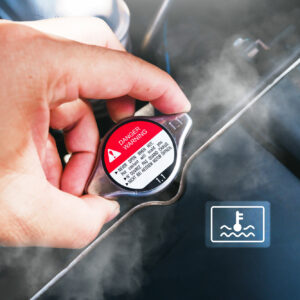Overfilling the coolant reservoir will cause the cooling system to push the coolant out of the pressure cap.
Often, an overflowing coolant reservoir is the result of human error. You might have simply overfilled your coolant reservoir and will need to drain it through the drain plug on the bottom of the radiator. Remember to use proper procedure when draining coolant.
But there may be other reasons for an overfilled coolant reservoir. Let’s take a closer look.
Overfilled Coolant Reservoir Causes and Solutions
Tracking down the main cause behind your overflowing coolant might take some investigating. In this section, we’ll be going over some of the most common causes and their possible fixes. Bring your vehicle to a trusted mechanic if you can’t figure out the main problem though. They can investigate your overflowing coolant further.
Ignoring Recommended Coolant Levels
The engine cooling system has a “full hot” line on the reservoir, and this is how you tell if it’s low or too full. If it’s too full, it’ll just push coolant out. If it’s too low, you need to add coolant, but always let the engine cool so that there is no pressure before opening the system and adding coolant.

Worn Radiator Cap
Before you check the other parts of the cooling system for damage, you ought to take a look at the radiator cap. Radiator caps are designed to keep the coolant at a specific pressure. A worn cap might be loose or damaged in some way, leading to coolant spilling out even if the reservoir isn’t too full. Your owner’s manual should have more about how to replace it if needed.
Faulty Thermostat
Coolant flows through the thermostat into the radiator when it hits 190 to 200 degrees. From there, the radiator cools the liquid down before releasing it back into the rest of the cooling system. The thermostat controls when the coolant flows into the radiator, but if the thermostat is faulty, it might not let the coolant through. The coolant gets trapped outside the thermostat if it’s stuck or otherwise malfunctioning. As a result, the radiator won’t be able to cool the coolant down. The liquid will continue to heat up and expand, spilling out the top of the coolant reservoir as a result. Replacing or repairing the thermostat should prevent the coolant from getting stuck.
Blocked Radiator
Like a faulty thermostat, a blocked radiator will prevent coolant from flowing through the system. Over time, rust and sediment gets trapped in the radiator and impedes the coolant flow. Clear the blockage in the radiator by performing a coolant flush. If that isn’t enough, it might be time to replace the radiator entirely.
Bad Water Pump
The water pump pumps coolant through the system, so a faulty water pump will slow or stop the coolant flow. As a result, the engine will overheat and coolant will spill out of the system. Replace the water pump if you notice coolant spilling out of the area around it.
Leaking Combustion Gas
Combustion gas and coolant both flow through the engine, but they follow different paths that aren’t meant to intersect. Coolant flows through passages in the engine block, cooling the engine as it goes. Meanwhile, the engine burns air and gas inside the combustion chamber, and it expels the resulting combustion gas through the exhaust system.
If the engine has either a cracked engine block or a blown head gasket, the combustion gases can escape and enter the cooling system. From there, the gases will push the coolant out of the passages and back into the reservoir, which can lead to the reservoir overflowing. Inspect the engine block and head gasket for damage and replace them accordingly.
Now that you know the likely causes behind your overflowing coolant reservoir, you can take the appropriate steps to address any issues. Coolant plays an essential role in keeping your engine cool. Refill your coolant to the appropriate levels, and keep an eye on other parts that aid its flow through the cooling system.
Any information provided on this Website is for informational purposes only and is not intended to replace consultation with a professional mechanic. The accuracy and timeliness of the information may change from the time of publication.





































